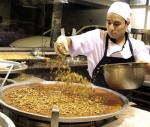You are here
The impact of regional instability on Jordan’s economy
Apr 09,2019 - Last updated at Apr 09,2019
Regional instability refers to political volatility in neighbouring countries, which mainly hinders the economic growth of any country. The Middle East, for instance, has experienced long periods of civil war resulting in social, political and economic consequences for the countries involved. The effect of the Middle East conflict includes slowing the growth rate of GDP due to reduced productivity, increasing the Jordanian military expenditure at the expense of other vital lifelines, increased unemployment rates, reduced foreign income, intensified borrowing to fund budget deficits and taking severe measures, such as tax increases. Nothing good emanates from being a neighbour to an unstable country. Although the state had witnessed a global financial crisis, its recovery plan was coincidentally hindered by the regional instability occasioned by the Syrian conflict.
Jordan’s trade routes were eliminated, causing a low growth rate of GDP by affecting export and import activities between Jordan and its trade partners. The increase in uncertainties about the future affects Jordan’s economic performance. Industrial production has dropped due to the higher tariffs being imposed on Jordan’s exports. For instance, Jordan lost export markets in Iraq, Kuwait and Saudi Arabia, and faced a fiscal deficit and a decline in tourism and transport revenues, which lowered the GDP growth. This effect on GDP growth affects everyone in any country. For Jordan, reduced productivity caused low profitability and downsizing of the work force. Hence, governments must form joint forces that ensure a peaceful and stable regional environment that fosters economic development in all sectors of the economy.
Jordan was forced to divert its finances to support the military activities to prevent the conflict from spilling over to Jordan. The military intervention was an attempt to protect its borders from militias and terminate the Syrian-Russian expansion. Financial resources directed towards military activities deprive other sectors of the economy of the essential resources to run them. For example, the education sector was much affected in terms of resource allocation, among other developmental initiatives. This means that Jordan is on the verge of becoming poor because it cannot sustainably provide for the basic needs of its population.
The labour market of the country has also been significantly affected. The unemployment rate in Jordan remains high, arising from a limited amount of natural resources and high population growth. The unstable political situation denies the vibrant sectors of Jordan from incorporating the young, educated youths actively, while exposing the local job market to competition from asylum seekers. As a result, most Jordanians have emigrated to the Arab Gulf countries in search for better employment opportunities that have helped Jordan to earn income through the remittances from the Jordanian workers overseas.
The conflict in the region obstructs Jordan’s economic growth due to insecurities, which in turn reduce foreign income in the tourism sector. The Syrian war directly affects the external environments of tourists’ destination by negatively impacting the hotel industry in Jordan. The country’s tourism sector is among the leading contributors to economic growth and generators of employment and revenues. The Kingdom’s economy can proliferate because it can create income and a crucial source of welfare. Hence, destinations should focus on guaranteeing safety and security of tourists during their visits because political instabilities in the Middle East threaten their life and safety.
Governmental budget deficits usually lead to borrowing, which currently is unsustainable for Jordan. The large population, coupled with high numbers of refugees from the Syrian war is straining the public resources at Jordan’s disposal, thus, the country’s public debt is unsustainable due to economic and social expenditure. The extra burden placed on the economy led to the current economic crisis the country is experiencing. Although the international community offered help to support Jordan, the assistance was insufficient to guard against the unfavourable repercussions of the crisis given the degree of the challenge. The government, therefore, opted to hire in the public sector as a response strategy to provide services to the refugee population. The education sector, for example, introduced second shifts to existing public schools with the help of the donor community, which resulted in overcrowding in schools. Generally, the refugee crisis in Jordan precipitated this economic crisis to what it is currently.
Governments in the Middle East region should address the issue of terrorism as a shared problem, whereby its elimination creates peaceful coexistence with neighbours. The cooperation can be achieved through sharing intelligence with the adversely affected countries, that is Jordan, and giving financial support and military interventions in the situations of extreme violence. Improved regional cooperation amongst Middle East countries guarantees improved security in the region that enables the continuation of trade activities for the prosperity of individual states.
Jordan has a better chance of recovering from the plague of economic crisis if other countries considered the Syrian war as a shared problem that needs joint efforts to solve. Jordan also needs a fast rate of structural transformations to facilitate an excellent growth recovery. Therefore, it requires resilient plans to alleviate the repercussions of the sociopolitical and economic mayhem of neighbouring countries for it to grow and develop economically. Foreign assistance should also be allocated to Jordan to counter the spill-over effects of conflicts and to improve economic recovery.
The writer is an international relations specialist. He contributed this article to The Jordan Times









